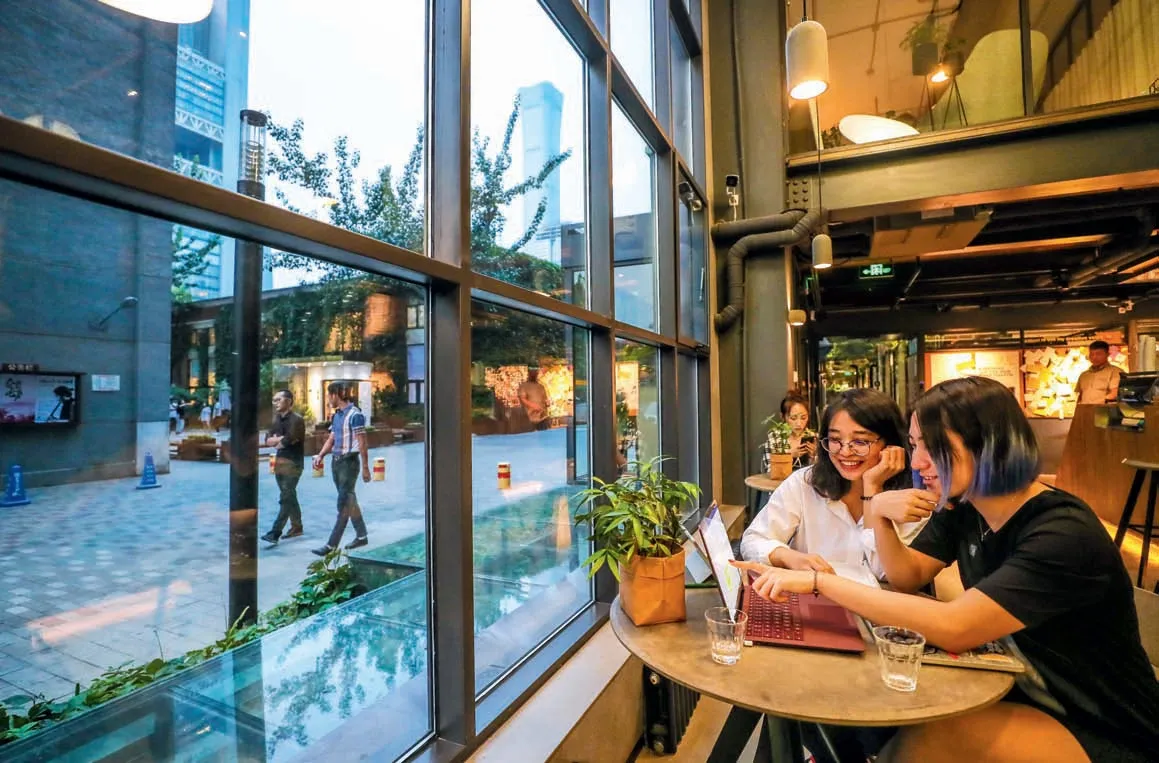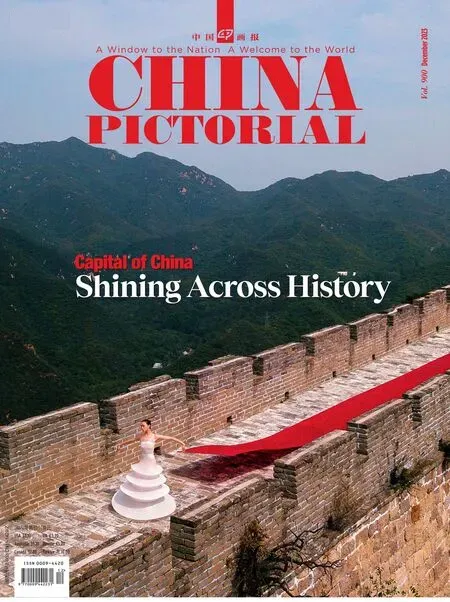Cutting-edge Old Sites
Text by Zhou Chenliang
Innovation empowered the old sites of factories and communities to become new cultural landmarks of Beijing.
As the national cultural center,Beijing has vigorously promoted the “Culture+”development strategy in recent years,highlighting the integration of culture with finance,science and technology,and tourism.It effectively released the vitality of Beijing’s scientific and technological resources,human resources,and innovation and creativity,and greatly empowered the city’s cultural development.
Many new cultural venues transformed from old factory sites and communities combined historical and cultural value,scientific and technological value,and economic and artistic value to become Beijing’s hubs for fashion and cultural consumption as well as popular“micro vacation” destinations.

Langyuan Station in Beijing is a shared ecological cultural space refurbished from the warehouses of Beijing Textile Factory.It has become an important urban memory connecting the history of the city’s industrial era and its modern civilization.(Photo from VCG)
Langyuan Vintage: Artistic Attractions

Colleagues socialize while working in an office building transformed from an old factory workshop.(Photo by Wu Yibin/Beijing Daily)
Beijing’s Central Business District (CBD) is filled with hustle and bustle day and night among various skyscrapers,including the 528-meter-tall China Tower and the iconic headquarters of China Central Television (CCTV).Obscured by the tall buildings,Langyuan Vintage sits in an old industrial park with ivy growing on red brick walls.
No.6 Langjiayuan Community,the site of Langyuan Vintage,was previously a medical equipment factory.In the 1990s,development and construction of the CBD caused local factories to gradually move outside the district.In 2008,the factory was completely gone.The next year,a cultural and creative industrial park was officially built based on the old plant buildings.
Since its birth,Langyuan Vintage has been committed to building an urban public cultural space hosting events such as film screenings,cultural salons,stage performances,theater festivals,book fairs,and other cultural activities.After more than 10 years of transformation and improvement,it has deeply integrated with Beijing’s urban development to become one of the city’s cultural and creative landmarks.
In addition,Langyuan Vintage has also successively developed the first wave of new consumer brand incubation bases in Beijing—Langyuan Station,Langyuan Park,just to name a few.The development path of Langyuan Vintage reflects Beijing’s exploration of the cultural industry in the past decade.
798 Art District:Factory-turned Art Park
Located on the Fourth Ring Road and close to the Central Academy of Fine Arts in northeastern Beijing,the 798 Art District boasts the unique Bauhaus architectural style,avant-garde art exhibitions,various artistic products with bold imagination,and installations in old industrial plant venues.Since its completion,it has been loved by many young people,attracting many artists and art institutions to move in.It has become the only place in Beijing to obtain qualification to create a national cultural industry demonstration park.
The 798 Art District is located at the original site of the North China Radio Equipment United Factory (718 United Factory).At the beginning of the 21st century,following the reform wave of state-owned enterprises,the factory began to reorganize its industrial structure and convert idle workshops into creative art spaces.As more and more spare workshops opened up,increasing numbers of artists began setting up studios here.In 2002,the prototype of the art district was formed.The artists renovated the plant buildings while maintaining the original industrial architectural style and opened galleries and studios for sculpture and architectural design,music performances,film and television broadcasts,clothing design,and home interior design.
The old industrial buildings combined with vibrant contemporary arts to form the distinctive style of the 798 Art District with the reputation of “a precious cultural relic in the history of human industrial development.”
Today,the 798 Art District has attracted hundreds of national cultural exchange centers,international cultural and art institutions,and well-known institutions that combine traditional Chinese and contemporary arts from 19 countries and regions around the world,becoming an important platform for cultural and artistic exchange between China and foreign countries.Now,in addition to daily exhibitions of major galleries,art museums,and other art institutions,the art district has also added public art and cultural activities such as film viewings and light concerts.

Shougang Park is one of the major venues of the China International Fair for Trade in Services in Beijing.(Photo from VCG)
Shougang Park:Steel the One
“The history of Shougang Steel reflects half of the history of Beijing.” On the bank of the Yongding River,a gala of the 2023 Beijing Cultural Forum kicked off in front of the Big Air Shougang,a sports stadium in Beijing’s Shijingshan District.Shougang Park is now a popular tourist attraction.
The former steel giant has now been transformed into a large-scale industrial heritage ecological cultural park,becoming an important symbol of Beijing’s in-depth urban transformation.It is also a witness of the development of industrial culture,a venue for the Winter Olympics,and a display area for innovative culture.
The history of Shougang can be traced back to 1919.Its predecessor was the Shijingshan Refinery of Longyan Iron Ore Co.,Ltd.established by the Beiyang government during the Republic of China period(1912-1949).It has shined with steel and fire and witnessed the progress of China’s steel industry for a century.
Shougang’s transformational journey began with Beijing’s successful bid for the 2008 Summer Olympics.The steel factory was relocated and adjusted to better serve the Olympics and Beijing’s new positioning.On December 21,2010,the fire went out in the No.1 blast furnace,the last furnace in operation at Shougang’s Shijingshan plant,and the steel town completed its historical mission and opened a new chapter.
The successful bid and hosting of the Beijing 2022 Winter Olympics officially turned the page for Shougang Park.Blast furnaces were transformed into exhibition venues,the power station was transformed into a café,and the factory buildings were transformed into supporting buildings for the Winter Olympics,the office park of the Winter Olympics Organizing Committee,and the training site of national winter sports teams.And the Big Air Shougang opened as the competition venue for freestyle skiing and snowboarding events at the Beijing 2022 Winter Olympics.The old steel town,retrofitted for the Winter Olympics,quickly went viral,attracting the attention of the world.

A New Year count-down light show in Beijing’s Shougang Park attracts countless visitors,December 31,2022.(Photo from VCG)
In the post-Winter Olympics period,Beijing has continued to consider protecting and developing Shougang’s industrial heritage very important.In 2022,an action plan to create a new landmark for revitalization of the capital in the new era and accelerate transformation and development of western Beijing was announced,which proposed making Shougang Park a new landmark in Beijing.The industrial heritage of the past is now being integrated into the development of the city in a new way.The China International Fair for Trade in Services and the China Science Fiction Conference were successively held there,bringing the spotlight back once again.

